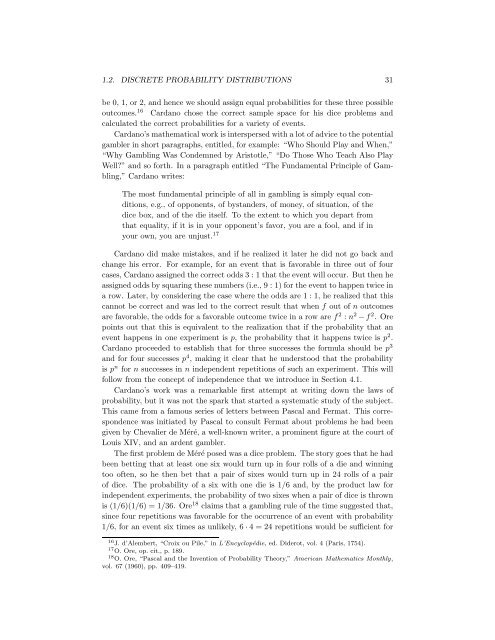Chapter 1 Discrete Probability Distributions - DIM
Chapter 1 Discrete Probability Distributions - DIM
Chapter 1 Discrete Probability Distributions - DIM
- No tags were found...
You also want an ePaper? Increase the reach of your titles
YUMPU automatically turns print PDFs into web optimized ePapers that Google loves.
1.2. DISCRETE PROBABILITY DISTRIBUTIONS 31be 0, 1, or 2, and hence we should assign equal probabilities for these three possibleoutcomes. 16 Cardano chose the correct sample space for his dice problems andcalculated the correct probabilities for a variety of events.Cardano’s mathematical work is interspersed with a lot of advice to the potentialgambler in short paragraphs, entitled, for example: “Who Should Play and When,”“Why Gambling Was Condemned by Aristotle,” “Do Those Who Teach Also PlayWell?” and so forth. In a paragraph entitled “The Fundamental Principle of Gambling,”Cardano writes:The most fundamental principle of all in gambling is simply equal conditions,e.g., of opponents, of bystanders, of money, of situation, of thedice box, and of the die itself. To the extent to which you depart fromthat equality, if it is in your opponent’s favor, you are a fool, and if inyour own, you are unjust. 17Cardano did make mistakes, and if he realized it later he did not go back andchange his error. For example, for an event that is favorable in three out of fourcases, Cardano assigned the correct odds 3 : 1 that the event will occur. But then heassigned odds by squaring these numbers (i.e., 9 : 1) for the event to happen twice ina row. Later, by considering the case where the odds are 1 : 1, he realized that thiscannot be correct and was led to the correct result that when f out of n outcomesare favorable, the odds for a favorable outcome twice in a row are f 2 : n 2 − f 2 . Orepoints out that this is equivalent to the realization that if the probability that anevent happens in one experiment is p, the probability that it happens twice is p 2 .Cardano proceeded to establish that for three successes the formula should be p 3and for four successes p 4 , making it clear that he understood that the probabilityis p n for n successes in n independent repetitions of such an experiment. This willfollow from the concept of independence that we introduce in Section 4.1.Cardano’s work was a remarkable first attempt at writing down the laws ofprobability, but it was not the spark that started a systematic study of the subject.This came from a famous series of letters between Pascal and Fermat. This correspondencewas initiated by Pascal to consult Fermat about problems he had beengiven by Chevalier de Méré, a well-known writer, a prominent figure at the court ofLouis XIV, and an ardent gambler.The first problem de Méré posed was a dice problem. The story goes that he hadbeen betting that at least one six would turn up in four rolls of a die and winningtoo often, so he then bet that a pair of sixes would turn up in 24 rolls of a pairof dice. The probability of a six with one die is 1/6 and, by the product law forindependent experiments, the probability of two sixes when a pair of dice is thrownis (1/6)(1/6)=1/36. Ore 18 claims that a gambling rule of the time suggested that,since four repetitions was favorable for the occurrence of an event with probability1/6, for an event six times as unlikely, 6 · 4 = 24 repetitions would be sufficient for16 J. d’Alembert, “Croix ou Pile,” in L’Encyclopédie, ed. Diderot, vol. 4 (Paris, 1754).17 O. Ore, op. cit., p. 189.18 O. Ore, “Pascal and the Invention of <strong>Probability</strong> Theory,” American Mathematics Monthly,vol. 67 (1960), pp. 409–419.
















